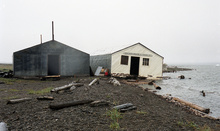 What is Digital Heritage?
What is Digital Heritage?
Digital heritage refers to the use of reality capture technologies such as terrestrial laser scanning (TLS) and photogrammetry to digitally capture heritage sites throughout the world. Our research team focuses specifically on the digital preservation of polar heritage sites using TLS and UAV/Drone photography. In addition to archiving heritage sites at risk in the Canadian Arctic by partnering with organizations such as CyArk, we are also exploring ways that digital heritage data can be used to develop sustainable practices in heritage management. This includes the use of TLS in developing long term heritage monitoring programs, as well as in mobilizing knowledge about polar heritage through the creation of educational websites and virtual heritage exhibits.
 What is Polar Heritage and Why is it Significant?
What is Polar Heritage and Why is it Significant?
Polar heritage usually refers to the physical remains of activities and events associated with Indigenous and Euro-North American peoples in the world's Arctic and Antarctic regions. Indigenous heritage sites illustrate the life ways and cultural values of Inuit, their Thule ancestors, and an earlier cultural group referred to by archaeologists as Paleoeskimo. In contrast, Euro-North American or "visitor" heritage is often associated with the "Heroic Age of Polar Exploration", encompassing such events as the First International Polar Year (1882/83), the search for a Northwest Passage, and the race to the North and South Poles. Visitor heritage can also include the material remains associated with commercial enterprises such as whaling and the fur trade, as well as with the activities of police detachments, missionaries, and the military in the north.
Visitor heritage sites all share characteristics that set them apart from those associated with Indigenous occupations. First, they utilize non-local materials and construction techniques that were subsequently imported into polar environments. Second, their occupants engaged in activities that were foreign to many Indigenous groups, including western scientific exploration and industrial scale resource exploitation. Third, while indigenous heritage generally reflects continuity in land use and occupancy, visitor heritage sites were abandoned once expedition objectives had been achieved, resources had been depleted, or mortal tragedies had taken place.
Polar heritage is significant because it marks the cultural achievements and resilience of indigenous peoples of the Canadian Arctic. Polar heritage also memorialise the ambitions of Euro-North American scientists and explorers, many of whom lost their lives in pursuit of their objectives. It is for these reasons that official designations of significance are often bestowed upon them. The three standing structures built by American Polar Explorer Robert Peary at Fort Conger in 1900, for example, have achieved the highest level of designation made by the Federal Heritage Buildings Review Office as Classified Federal Heritage Buildings; the same accorded Canada’s Parliament Buildings in Ottawa. Fort Conger is also one of two places in the Arctic at which the Historic Sites and Monuments Board of Canada (HSMBC) commemorates the First International Polar Year (IPY) of 1882-83 as a National Historic Event. In the western Canadian Arctic, the Inuvialuit Final Agreement (IFA) protects existing historical, cultural, archaeological and paleontological resources adjacent to Pauline Cove on Herschel Island.
 Why Digitally Preserve Polar Heritage?
Why Digitally Preserve Polar Heritage?
The impacts of climate change and human caused destruction presently threaten many polar heritage sites of national and international significance. Reductions in sea ice have resulted in storm surges that can flood heritage sites, many of which are located close to sea level in coastal areas. Erosion caused by storms and thawing permafrost often create land subsidence that can threaten historic buildings. Warming temperatures are altering the micro-climates present in building interiors, promoting the growth of wood destroying fungi. The activities of humans, past and present, also pose considerable risks. Toxins like arsenic trioxide, which were used by 19th century polar scientists to preserve natural history specimens, were often left at expedition bases like Fort Conger. The cannisters that contained these chemicals have long since broken down, leaving behind a toxic legacy that now threatens many polar heritage resources. Likewise, rising interest in adventure tourism has brought cruise ships into various regions of the Canadian Arctic where disembarking passengers can cause irreparable damage to fragile heritage sites.
Our research explores how reality capture technologies such as terrestrial laser scanning can be used to digitally preserve these important sites in light of such threats. We are also exploring how the digital data captured by laser scanners can be used to develop site-based monitoring programs, as well as create photo-realistic reconstructions of polar heritage sites, making them "virtually" accessible to the general public.









 What is Digital Heritage?
What is Digital Heritage? What is Polar Heritage and Why is it Significant?
What is Polar Heritage and Why is it Significant?  Why Digitally Preserve Polar Heritage?
Why Digitally Preserve Polar Heritage?